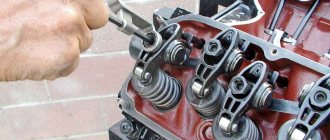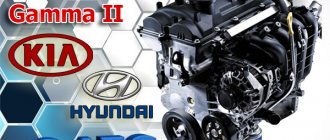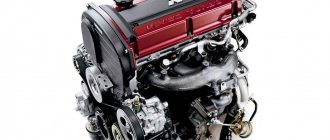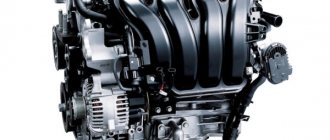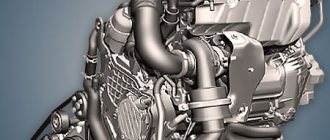The engine of a car is one of the most important places in any model and the Creta is no exception. In this case, Korean engineers have done a great job and provide the consumer with really good quality of the product and assembly in general. Read more in the article.
What exactly are you interested in?
- Hyundai Creta SUV engine characteristics
- 1.6 engine review Owner reviews
- Owner reviews
- Engine problems
Hyundai Creta SUV engine characteristics
First of all, many car enthusiasts are interested in the important question of whose engine is installed on the Hyundai Creta. The answer is banal and simple - this is Hyundai’s own development. The unit has long been used, although not in its current form, on many other models of the manufacturer. The Hyundai Creta engine is produced and assembled at the company’s factories both in Korea and China. Even though they are made by the Chinese, this does not in any way affect the build quality. The process is fully controlled by representatives of the manufacturer's company.
An interesting fact is the use of a timing chain instead of a belt in the design. This has its pros and cons.
At the moment, the Korean manufacturer has launched the production of two engines with a volume of 1.6 and 2.0. The power according to the passport (not to be confused with the nominal) is 123 horsepower 150 hp, respectively.
“Cutting off” power to 150 hp. artificial and caused only by the manufacturer’s unwillingness to pay additional taxes to the state. In fact, the two-liter unit can easily produce 165 hp.
These powers are quite enough for good driving dynamics and acceleration of the SUV. The actual rated power is achieved after a certain mileage after running in. Running in the engine of the new Creta is really important and subsequently affects its performance, endurance and service life.
The resource declared by the manufacturer is only 200,000 km. mileage, which is quite small. But proper operation and timely maintenance can significantly extend the service life of the product.
Experts note the increased reliability of the engines of the Creta SUV. And they note that Solaris has the same engines with the same declared service life, but in reality the engines last half a million without major repairs.
Both versions of the Hyundai Creta engines are gasoline with distributed injection, and diesel engines are not available today. Many specialized authoritative media outlets are already writing about plans for their production and the configuration of the SUV. There is a very high probability that the 1.7 liter diesel engine of the Hyundai Creta will appear on the market this year.
No matter how it is, the choice before the buyer is difficult. Which engine should you choose for your Creta, which engine will be better? Although the choice is not great, there are only two options (1.6 or 2.0), but it is quite serious. A brief overview of these units below in this article will help you do it.
Technical characteristics of Greta
In the Russian market, Creta is available with two types of gasoline engines. The base unit is a 1.6-liter unit with twin camshafts and multipoint injection technology. Maximum engine power is 123 hp. Torque - 151 nm. This drive can be equipped with a 6-speed manual or automatic transmission. However, all torque will be directed only to the front axle. Version 1.6 with all-wheel drive is only available as an option.
| Body type | crossover |
| Number of seats | 5 |
| length | 4270 mm |
| width | 1780 mm |
| height | 1630 mm |
| wheelbase | 2590 mm |
| Front wheel width | 1570 mm |
| Rear track width | 1587 mm |
| Own weight | 1377 kg |
| gap | 190 mm |
| Total weight | 1752 kg |
| Trunk and cargo space | |
| Minimum luggage volume | 419 l |
| Maximum baggage capacity | 1280 l |
| Engine | |
| engine's type | petrol |
| Engine capacity | 1591 cm3 |
| Engine power | 123 hp |
| Maximum rotation power | up to 6300 rpm |
| Maximum torque | 157 Nm |
| Power type / Power supply | injector |
| Cylinder arrangement | row |
| Number of cylinders | 4 |
| Number of valves per cylinder | 4 |
| Maximum torque rotation | 4850 rpm |
| Fuel type | Pb95 |
| Transmission | |
| Gearbox type | mechanical |
| Number of gears | 6 |
| drive unit | front |
| Performance | |
| Maximum speed | 171 km/h |
| Acceleration (0-100 km/h) | 11.1s |
| Fuel tank capacity | 60 l |
| Combined fuel consumption per 100 km | 6.9 l |
| Brakes and suspension | |
| Front brakes | disks |
| Rear brakes | brakes |
| Front suspension | Independent, MacPherson column, spring, roll stabilizer |
| Front suspension | Independent, Shock absorbers, springs |
2-liter power units are also available in luxury configurations. This engine is equipped with increased power of 149 hp. (the parameter is specially tailored for the lowest transport tax). The maximum engine torque is 192 Nm. The engine is equipped with a 6-speed automatic transmission. Is it possible to assign a Hyundai Creta 4WD? Auto experts say that the two-liter version is available with removable all-wheel drive with a multi-plate clutch. The SUV automatically connects the rear axle if necessary. And on the road (and all asphalt surfaces) only front-wheel drive works, which saves a lot of fuel.
1.6 engine review
The Crete 1.6 is equipped with a Gamma G4FG brand engine produced by the Korean company. The unit has a simple modern engine design. The timing system is equipped with a chain instead of a belt, which increases reliability and leads to savings during operation. The power plant uses CVVT technology and the software has been radically redesigned, which made it possible to increase the power of the power plant to the level required by engineers.
1.6 has a power of 123 hp, but at the same time shows excellent dynamics, which was noted by many specialists in this field during test drives. The 4x4 version of the Creta with a 1.6 engine demonstrates excellent acceleration and driving times both downhill and off-road.
Technical characteristics of the 1.6 liter engine:
- Resource - 180 - 200 thousand.
- Fuel - gasoline (in some cases even 92)
- Cylinders - 4
- Valves -16
- In-line arrangement of cylinders
- Power 123 hp
- Maximum torque – 150.7 Nm at 4,850 rpm.
- Volume - 1.6 l.
Pros and cons:
- The price in any configuration will be lower.
- Consumption is lower than that of 2.0, but, judging by the reviews of the owners, it wants better.
- Short service life declared by the manufacturer.
Owner reviews
Ivan. Permian.
We spent a long time choosing between 1.6 and 2.0 - in the end we settled on the first option. To this day, we have never regretted our choice even once. The power is quite enough for trips around the city and into the countryside. To take the oil I didn’t notice. The mileage is 37,000 km - the flight is normal.
Igorek. Kaluga.
Consumption is a little disappointing in the city. Quite big for 1.6, in my opinion. Eight liters is something you still have to try to invest in. As for operation, there are no problems with this already at a mileage of 20 thousand.
Sergey. Samara.
After Logan, this SUV only makes me happy. There are no problems with the engine, chassis, or body. I undergo maintenance regularly and only at a service center, although it is a little expensive, but this way the guarantee is maintained. Share information about how much the first maintenance cost.
Engine Hyundai Creta 1.6 liters
The Creta's engine is almost entirely aluminum. This is both the cylinder block and the cylinder head. Moreover, the design lacks special crankshaft covers. Cast aluminum pastel is used to attach it to the cylinder block. The lightness of this design also has a negative point; these are serious problems when the engine overheats. In some cases, overheating of the motor causes such deformation of engine parts that it can be safely thrown into the trash.
Creta 1.6 liter cylinder head
The aluminum cylinder head of the Creta has a 16 valve design with two overhead camshafts. This is a typical DOHC with no hydraulic compensators. That is, on a fairly modern engine you will have to adjust the valve clearance manually. In addition, there are special oil channels in the block head through which the phase shifters are controlled. The higher the pressure, the more the CVVT actuator deflects the camshaft, changing the valve timing. Special sensors, solenoid valves and control electronics are responsible for all this.
Changing the valve timing allows you to optimize engine operation in any mode, thereby achieving the best combination of power, fuel consumption and harmful exhaust emissions.
Engine specifications 2.0
The two-liter engine in any configuration of the Creta is branded Nu G4NA. This is also a Korean development, and in fact it is a replacement for the outdated G4KD engine.
It is worth noting! They were distinguished by their endurance and reliability. The service life, with proper maintenance, easily reached 500,000 km. mileage
In fact, the unit has been significantly redesigned for the better. First of all, it should be noted the use of the CVVT system, which is installed in both the start and exhaust systems.
It is possible to refuel 92 with gasoline of proper quality, which cannot but please the domestic car enthusiast.
This unit, like its smaller brother, uses a chain instead of a belt.
Specifications:
- Fuel used: gasoline
- Cylinder capacity - 2000 cc.
- Number of cylinders - 4 pcs.
- Number of valves - 16 pcs.
- In-line arrangement of cylinders.
- Maximum power – 150 hp. With. at maximum rpm.
- The maximum possible torque is 201 Nm at 4,800 rpm.
Owner reviews
Artem. Voronezh.
I am completely and one hundred percent satisfied with the engine of my Hyundai Creta. Never once has he ever let me down, regardless of the situation. Although over the 30,000 mileage the situations were different: it happened in a swamp and under snow-covered drifts. Consumption, of course, cannot please you - nevertheless, the volume makes itself felt.
Ivan. Arkhangelsk.
We waited a little longer for our car, because we wanted our Creta’s engine to be two-liter. It is worth noting that several months of long waits were not wasted in vain. As for me, a stronger unit will have a longer service life. But this is purely my private opinion. We are happy with the car, it has never let us down in 40 thousand km. mileage I can recommend it!
Ignat. Peter.
Two liters under the hood is real power. The car only ran 18,000 and, as for me, it’s too early to draw any global conclusions. I didn’t have any problems during the entire period of use. But the period is not that long—not even two years yet. One winter passed without problems. The maximum frost in our area was around -24. Started without any additional movements.
Vova. Kirov.
All these expert opinions regarding the aluminum cylinder block are probably custom-made. Aluminum blocks are installed on VIP class cars. What are we talking about?
Detailed technical characteristics of Creta
| Engine | ||||||
| Engine capacity | 1.6 l. | 1.6 l. | 1.6 l. | 1.6 l. | 2 l. | 2 l. |
| Power | 123 hp | 121 hp | 123 hp | 121 hp | 149.6 hp | 149.6 hp |
| Engine | Gamma 1.6 D-CVVT (2WD) | Gamma 1.6 D-CVVT (4WD) | Gamma 1.6 D-CVVT (2WD) | Gamma 1.6 D-CVVT (4WD) | Nu 2.0 D-CVVT | Nu 2.0 D-CVVT |
| Volume, cm3 | 1591 | 1591 | 1591 | 1591 | 1999 | 1999 |
| Maximum power, kW at rpm | 90.2 / 6300 | 88.7 / 6200 | 90.2 / 6300 | 88.7 / 6200 | 110 / 6200 | 110 / 6200 |
| Maximum power, hp at rpm | 123 / 6300 | 121 / 6200 | 123 / 6300 | 121 / 6200 | 149.6 / 6200 | 149.6 / 6200 |
| Maximum torque, Nm at rpm | 150.7 / 4850 | 148.3 / 4850 | 150.7 / 4850 | 148.3 / 4850 | 192 / 4200 | 192 / 4200 |
| Fuel tank, l | 55 | |||||
| Fuel | Gasoline, AI-92 and higher | |||||
| Environmental class | 5 (fifth) | |||||
| CO2 emissions in the urban cycle, g/km | 207 | 222 | 216 | 232 | 239 | 248 |
| CO2 emissions in the extra-urban cycle, g/km | 133 | 144 | 137 | 147 | 140 | 153 |
| CO2 emissions in the combined cycle, g/km | 161 | 173 | 166 | 178 | 177 | 188 |
| Automatic gearbox | — | — | + | + | + | + |
| Dynamic characteristics | ||||||
| Drive unit | 2WD | Full | 2WD | Full | 2WD | Full |
| Transmission | 6 manual transmission | 6 manual transmission | 6 automatic transmission | 6 automatic transmission | 6 automatic transmission | 6 automatic transmission |
| Acceleration time (0-100 km/h, sec) | 12.3 | 12.9 | 12.1 | 13.1 | 10.7 | 11.3 |
| Max. speed, km/h | 169 | 167 | 169 | 167 | 183 | 179 |
| Fuel consumption | ||||||
| Urban cycle, l/100 km 4 | 9 | 9.6 | 9.2 | 9.9 | 10.2 | 10.6 |
| Extra-urban cycle, l/100 km 4 | 5.8 | 6.2 | 5.9 | 6.3 | 6 | 6.5 |
| Combined cycle, l/100 km 4 | 7 | 7.4 | 7.1 | 7.6 | 7.5 | 8 |
| Mass (weight) | ||||||
| Curb weight, kg, min-max | 1345 ~ 1385 | 1420 ~ 1450 | 1374 ~ 1454 | 1440 ~ 1520 | 1405 ~ 1485 | 1472 ~ 1552 |
| Total weight, kg | 1795 | 1850 | 1825 | 1890 | 1855 | 1925 |
| Weight of towed trailer without brakes | 550 | 550 | 550 | 550 | 550 | 550 |
| Weight of towed trailer equipped with brakes | 1300 | 1300 | 1100 | 1100 | 1100 | 1100 |
| Suspension | ||||||
| Wheelbase | 2590 | |||||
| Minimum ground clearance, mm | 190 | |||||
| Front track | 1557 (16″ tires) | 1557 (16″ tires) | 1557 (16″ tires) | 1557 (16″ tires) | 1557 (16″ tires) | 1557 / 1545 (16″ / 17″ tires) |
| Rear track | 1570 (16″ tires) | 1570 (16″ tires) | 1570 (16″ tires) | 1570 (16″ tires) | 1570 (16″ tires) | 1568 / 1556 (16″ / 17″ tires) |
| Front overhang | 840 | |||||
| Rear overhang | 840 | |||||
| Front suspension | Independent, McPherson struts with springs and anti-roll bar | |||||
| Rear suspension | Semi-independent, spring, with shock absorbers | Independent, multi-link | Semi-independent, spring, with shock absorbers | Independent, multi-link | Semi-independent, spring, with shock absorbers | Independent, multi-link |
| Front brakes | Ventilated disc: Ø280 mm | Ventilated disc: Ø280 mm | Ventilated disc: Ø280 mm | Ventilated disc: Ø280 mm | Ventilated disc: Ø280 mm | Ventilated disc: Ø280 mm or Ø300 mm |
| Rear brakes | Disc Ø262 mm | |||||
| Control | ||||||
| Type | Electrically powered, rack and pinion | |||||
| Number of turns to stop | 2.8 | |||||
| Minimum turning radius, m | 5.3 | |||||
| Dimensions | ||||||
| Number of places | 5 | |||||
| Overall dimensions: length, width, height | 4,270 mm / 1,780 mm / 1,630 mm (1,665 mm with roof rails) | |||||
| Legroom: front / rear, mm | 1034 ~ 1112 (min~max) / 942 | |||||
| Height from seat to ceiling: front / rear, mm | 1015 / 995 | |||||
| Interior width at shoulder level: front / rear, mm | 1387 / 1365 | |||||
| Trunk volume, l (VDA) | 402 / 1396 | |||||
| Interior width at hip level: front / rear, mm | 1371 / 1319 | |||||
| Are common | ||||||
| Discs | 6.0Jx16 | 6.0Jx16 | 6.0Jx16 | 6.0Jx16 | 6.0Jx16 | 6.0Jx16; 6.5Jx17 |
| Tires | 205/65R16 95H | 205/65R16 95H | 205/65R16 95H | 205/65R16 95H | 205/65R16 95H | 205/65R16 95H; 215/60R17 96H |
Hyundai solaris 1.6 at comfort (01.2011 - 03.2013) - technical specifications
Speed characteristics of Hyundai Creta engines
The weight of the Hyundai Creta is 1377 kilograms.
By giving its compact crossover, almost completely identical to the well-received ix25 in China, the name Creta, Hyundai is clearly hinting at the Greek island of Crete, whose history is associated with the flourishing of ancient culture. Time will tell whether the new product will become such for the automotive culture of Russia. In the meantime, we can note the good technical characteristics of the Hyundai Greta 2021 and a stylish exterior with lensed headlights with diode running lights and 17-inch wheels. The new product is also equipped with keyless engine start, 6 airbags, a multimedia navigation system with a 5-inch touch screen and six speakers, a rear view camera, etc.
Let us remind you that many people incorrectly say the technical characteristics of the Hyundai Greta, while the name of the car begins with “K”.
Video test drives of the crossover can be found here: https://www.hyundai-creta2.ru/video-hyundai-creta
Or read owner reviews
Exploitation
Despite the real reliability and unpretentiousness of the engines of the Hyundai Creta SUV, it has its own operating features that you need to know about in order to extend its life. The most vulnerable part in this product from the Korean manufacturer is the cylinder block. It is made of aluminum. It would seem that this is only a plus:
- Firstly, it has less mass.
- Secondly, it does not rust at all.
But along with the advantages, there are also disadvantages:
- Has increased wear.
- Its maintainability is practically zero.
In addition to the previously described possible problems as the vehicle is used, there are others:
- Problematic repair of Hyundai Creta engines in general. Many services refuse to do this.
- Low operating life of units. Although in reality this is far from the case.
- The problematic cylinder block, as already written about, is designed for 200-250 thousand mileage. After that, only replacement, since repair is not possible in practice.
Engine problems
During the operation of the car, some owners already after 30-40 thousand km. mileage often begin to complain about all possible different problems with the engine of the Hyundai Creta. In this section we will look at each of the options for these troubles and try to give advice on how to avoid this in your own cases.
Among the main problems we can safely highlight the following:
- Engine knock.
- Vibration at different speeds.
A knock in the engine of your favorite Creta should not be immediately mistaken for a malfunction. Depending on the format and the sound itself, it is quite possible that we are dealing with a robot of hydraulic compensators.
The Korean manufacturer began to use hydraulic compensators in its engines for the first time.
They can indeed make a knocking noise when the car is cold, but it should go away after heating to an operating temperature of ninety degrees.
The second source may be circuit operation. In this case, it is better to consult with the service center specialists.
Vibrations can have several sources:
- The production of spark plugs depends on the driving style and the quality of the fuel being filled.
- Clogged gasoline injection system. Experts recommend replacing the fuel filter every 60 thousand kilometers.
- The motor entering resonance is not a problem or breakdown at all.
- Failure of motor mounts. This problem occurs quite often even at low mileage.
Engine and gearbox
| Type | Volume | Power | Torque | Overclocking | Maximum speed | Number of cylinders |
| Petrol | 1.6 l | 123 hp | 151 H*m | 12.3 sec. | 169 km/h | 4 |
| Petrol | 1.6 l | 121 hp | 148 H*m | 12.9 sec. | 167 km/h | 4 |
| Petrol | 2.0 l | 149 hp | 192 H*m | 10.7 sec. | 183 km/h | 4 |
More details
Russian consumers can purchase a crossover with only two types of engines. Both of them are naturally aspirated petrol.
The first 16-valve 1.6-liter engine is installed on budget modifications of the model. This is a 4-cylinder engine that has distributed injection. To produce maximum power of 123 hp, it will have to be revved up to 6500 rpm. A torque of 151 Nm is available a little earlier – from 4900 rpm.
This engine is paired with both a 6-speed manual automatic transmission and a 6-speed automatic transmission. Both of these gearboxes redirected all the torque to the front wheels, but since March 2017, Hyundai began installing all-wheel drive as an option for modification.
Depending on the type of drive and the selected gearbox, the engine exhibits different dynamic performance and fuel consumption.
1.6MT 2WD:
- acceleration – 10.1 sec;
- maximum speed – 169 km/h;
- combined cycle consumption – 7 liters.
The all-wheel drive version of the Hyundai Creta demonstrates the same acceleration and maximum speed, but the combined cycle consumption is 7.4 liters.
1.6AT 2WD:
- acceleration – 12.3 sec;
- maximum speed – 169 km/h;
- consumption in the combined cycle is 7.1 liters.
The all-wheel drive version can accelerate in 10.1 seconds and consume 7.6 liters. The permissible speed remains the same.
The second engine is also an in-line four, but with a volume of 2.0 liters. The 16-valve engine develops 149 hp, available from the same speed as its younger brother, and 192 Nm of torque.
The drive here is standard front-wheel drive, but all-wheel drive is optionally available. Using a multi-plate clutch, when the front wheels slip, part of the power will be transferred to the rear wheels.
The two-liter engine is paired only with an automatic transmission.
Depending on the type of drive, the Creta also has different characteristics.
2.0 AT 2WD:
- acceleration – 10.7 seconds;
- maximum speed – 183 km/h;
- consumption – 7.1 liters.
2.0 AT 4WD:
- acceleration – 11.3 seconds;
- maximum speed – 179 km/h;
- consumption - 8 liters.
Let's sum it up
In general, the Creta’s engine, like the SUV itself, deserves the buyer’s attention. It has its pros and cons, the main one being the aluminum cylinder block. Or rather, its resource is only 200,000 km. and no possibility of repair. On the other hand, this point is of course taken into account in the price of the car. And replacing the entire cylinder block is not impossible, although it is quite expensive.
Among the advantages, we should highlight the high-tech approach to the production of power plants by the Koreans, endurance, efficiency, and the ability to fill with 92 gasoline.
Specifications of Hyundai Creta 2021
Under the hood of the updated Hyundai Creta, the same engine, transmission and drive (front-wheel or all-wheel drive) remain the same. The manufacturer simply did not experiment with these mechanisms for Russia, since this is not the case, here reliability is in the foreground rather than cost. In terms of the variety of units, a petrol version is available, with a volume of 1.6 liters and 123 hp. or 121 hp, as well as a gasoline unit with a volume of 2.0 liters and a power of 149.6 hp.
| Technical specifications of Hyundai Creta 2020 | |||
| Engine | Gamma 1.6 D-CVVT | Gamma 1.6 D-CVVT | Nu 2.0 D-CVVT |
| Fuel | Gasoline AI-92 | Gasoline AI-92 | Gasoline AI-92 |
| Number of cylinders/valves | 4/16 | 4/16 | 4/16 |
| Volume, l | 1,6 | 1,6 | 2,0 |
| Power, hp | 123 | 121 | 149,6 |
| Torque, Nm | 150,7 | 148,3 | 192 |
| Maximum speed, km/h | 169 | 167 | 10,7 |
| Acceleration time to 100 km/h, s | 12,3 | 13,1 | 11,3 |
| Transmission | 6 manual transmission | 6 automatic transmission | 6 automatic transmission |
| Drive unit | 2WD | 4WD | 2WD/4WD |
| Fuel consumption Hyundai Creta 2020 | |||
| Around the city, l | 9 | 9,6 | 10,2 |
| On the highway, l | 5,8 | 5,9 | 6 |
| Mixed cycle, l | 7 | 7,1 | 7,5 |
| CO2 emissions, g/km | 207 | 2 | 248 |
The suspension of the updated Hyundai Creta largely depends on the configuration, more precisely on the type of drive. The front has an independent suspension as standard, with MacPherson struts and an anti-roll bar. As for the rear suspension, for 2WD modifications, the manufacturer installed a semi-independent suspension on springs and shock absorbers. All-wheel drive versions of the crossover received an independent multi-link suspension at the rear.
| Dimensions and weight of Hyundai Creta 2020 | |
| Length, mm | 4270 |
| Width, mm | 1780 |
| Height, mm | 1630 (with rails 1665 mm) |
| Wheelbase, mm | 2590 |
| Front wheel track, mm | 1557-1545 |
| Rear wheel track, mm | 1556-1570 |
| Fuel tank volume, l | 55 |
| Trunk volume, l | 402 (with seats folded 1396 l) |
| Curb weight, kg | 1345-1520 |
As you can see, in terms of technical characteristics, the updated Hyundai Creta has remained the same, only the weight has changed and that is due to new exterior parts. On the other hand, this is a plus, since playing with a CVT on other Hyundai models did not show the best results, and in Russia, according to various sources, they prefer the old proven automatic transmission rather than the new CVT.

